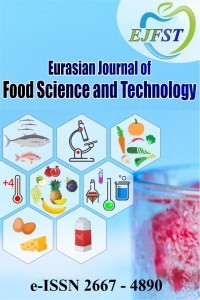APPLICATION OF NANOTECHNOLOGY IN FOOD PACKAGING
APPLICATION OF NANOTECHNOLOGY IN FOOD PACKAGING
Food packaging, health risk nanotechnology, nanomaterial, regulations,
___
- 1. Mura, S., Carta, D., Roggero, P., Cheli, F., Greppi G.F. 2014. Nanotechnology and its applications in food and animal science. Food Science, 26.91-102
- 2. Hatzigrigoriou, N. B., Papaspyrides C. D. 2011. Nanotechnology in Plastic Food-Contact Materials. Journal of Applied Polymer Science, Vol. 122, 3720–3739.
- 3. Cushen, M., Kerry, J., Morris, M., Cruz-Romero, M., Cummins, E. 2012. Nanotechnologies in the food industry e Recent developments, risks and regulation. Trends in Food Science & Technology 24:30-46.
- 4. Otles, S., Yalcin, B. 2013. Food Chemistry and Nanoscience. J Nanomater Mol Nanotechnol, 2:4
- 5. Chellaram, C., Murugaboopath G., John, A.A., Sivakumar, R., Ganesan, S., Krithika, S., Priya G. 2014. Significance of Nanotechnology in Food Industry. APCBEE Procedia 8:109 – 113.
- 6. Buzby. C. 2010. Nanotechnology for Food Applications. More Questions Than Answers. The Journal of Consumer Affairs, Vol. 44:3.
- 7. Lopes, C.M., Fernande, J.R., Lopes, P.M., 2013. Application of Nanotechnology in the Agro-Food Sector. Faculty of Health Sciences, 51 (2): 183-197.
- 8. Dobrucka, R. 2014. Applıcatıon Of Nanotechnology In Food Packagıng. Microbiol Biotech Food Science, 3 (5): 353-35.
- 9. Silva, H., Cerqueira, M. A., Vicente, A.A. 2012. Nanoemulsions for Food Applications: Development and Characterization. Food Bioprocess Technol 5:854–867.
- 10. Rashid, L., & Khosravi-Darani, K.2011. The Applications of Nanotechnology İn Food Industry. Critical Reviews in Food Science and Nutrition, 51:8, 723-730.
- 11. Commission Recomendation of 18 October 2011 on the definition of nanomaterial 2011/696/EU. 2011.
- 12. Alfadul S.M., Elnesh A.A. 2010. Use of Nanotechnology In Food Processıng, Packagıng And Safety. African Journal Of Food Agriculture Nutrition and Development, Volume10, No:6
- 13. Prasad, R., Kumar, V., Prasad, K.S. 2014. Nanotechnology in sustainable agriculture: Present concerns and future aspects. African Journal of Biotechnology, vol. 13(6):705-713.
- 14. Lee, D.S., Yam, K.L., Pıergıovannı, L. 2008. Overwiew of Food Packaking system. Food Packaging Science and Technology.1:1-1
- 15. Robertson, G.L., Introduction to Food Packaging. Food Packaging Principles and Practice.1: 1-9.
- 16. Üçüncü, M. 2000. Ambalaj, ambalajlama ve ambalajdan beklentiler. Gıdaların Ambalajlanması.1: 4-6.
- 17. Yang, W., Fortunati, F., Dominici, G., Giovanale, A., Balestra, G.M., Kenny, J.M., Puglia, D. 2016. Synergic effect of cellulose and lignin nanostructures in PLA based systems for food antibacterial packaging. European Polymer Journal, 79:1–12.
- 18. Dasgupta, N., Ranjan, S., Mundekkad,S., Ramalingam, C., Shanker, R., Kumar, A. 2015. Nanotechnology in agro-food: From field to plate. Food Research International, 69 : 381–400.
- 19. Mihindukulasuriya, S., Lim L. 2014. Nanotechnology development in food packaging: A review. Trends in Food Science & Technology, 40: 149-167.
- 20. Silvestre, C., Duraccio, D.,Cimmino S. 2011. Food packaging based on polymer nanomaterials. Progress in Polymer Science 36: 1766–1782
- 21. Sozer, N., Kokini, J, L. 2011. Nanotechnology and its applications inthe food sector. Trends in Biotechnology, Vol.27 No.2
- 22. Ranjan, S., Dasgupta, N., Chakraborty A. R., Samuel, S.M., Ramalingam C., Shanker, S., Kumar, A. 2014. Nanoscience and nanotechnologies in food industries: opportunities and research trends. J Nanopart 16:2464.
- 23. Momin J, K., Jayakumar, C. Prajapati, B,J. 2013. Potential of Nanotechnology in Functional Foods. Nutrıtıon and Food Science, 25 (1): 10-19.
- 24. Prasad, R., Kumar, V., Kumar, S.P. 2014. Nanotechnology in sustainable agriculture: Present concerns and future aspects. Akademic Journals, Vol. 13(6): 705-713.
- Yayın Aralığı: Yılda 2 Sayı
- Başlangıç: 2017
- Yayıncı: İlknur BAĞDATLI
Merve Gozde COSKUN, Perihan YOLCI OMEROGLU, Omer Utku COPUR
Gülşah KANBUR, Yusuf CUFADAR, Rabia GÖÇMEN, Ahmet ÜNVER
APPLICATION OF NANOTECHNOLOGY IN FOOD PACKAGING
Merve Gozde COSKUN, Omer Utku COPUR, Perihan Yolci OMEROGLU
Characterization of fatty acids composition in Iranian Phishomi extra-virgin olive oil
Asghar AMANPOUR, Songul KESEN, Hasim KELEBEK, Serkan SELLI
Temperature dependency of sweet cherry concentrate colour: a kinetic study
Şelale YALÇINÖZ, Emine ERÇELEBİ
Effects of Cultivar, Maturity Index and Growing Region on Fatty Acid Composition of Olive Oils
Songül KESEN, Asghar AMANPOUR, A. Salih SONMEZDAG, Hasim KELEBEK, Serkan SELLİ
MATHEMATICAL MODELING OF APRICOT DRYING
Physicochemical and Nutritional Properties of Bitter Melon at Four Maturation Stages
Yasin OZDEMIR, Aysun OZTURK, Senem TUFEKCI, Ozge KESKINEL, Rena İ. KOSTI
